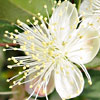In biblical language, Common Myrtle is called “leafy trees”. The myrtle symbolizes success and the eternity of life: “If you dream about myrtle, your property will prosper, and, if you don’t have property, you will inherit property” (Berachot 57: 1).
In Judaism it is customary to bless on wine and myrtle in the circumcision, redemption of the first born, and havdalah rituals.
The plant is one of the four kinds that are blessed on Sukkoth. The four kinds are grouped together as a symbol for the unity of the People of Israel. The sages compared Israel to the four kinds (Leviticus Raba) “The myrtle (hadas) has a good smell but no taste, symbolizing those who possess good deeds but do not study Torah”.
The leaves of the myrtle are fragrant, resistant to drought, arranged alternately on the stem. For fulfillment of the commandment, at least three leaves must emerge from the stem from one point, when it is “treble” and kosher (leafy tree). Myrtus communis trees are sometimes given special treatment that causes more branches to grow trebly, and growing them becomes commercial.
Young myrtle leaves resemble those of Ruscus aculeatus (Jew's Myrtle, Butcher's Broom), “since they grew and bloomed, one gives fragrance and the other thorns”. This comparison was made by the sages for Jacob and Esau, who were similar when they were born, but went in different ways when they grew up.
In the Mishnah, the myrtle is mentioned as something with which “the bride enters the canopy”. Alternately, it is placed on a dead person’s bed (the eternity of life).
The myrtle is regarded as a symbol of the good and the beautiful: “Instead of the thorn shall come up the fir tree, and instead of the brier shall come up the myrtle tree” (Isaiah 55: 13).
Bible exegetes explain that this identification is according to an ancient tradition that was passed from generation to generation. As mentioned, fresh myrtle leaves are necessary for fulfillment of the commandment, where three leaves emerge from the same place on the stem. Each stem must be at least 29 cm long.








